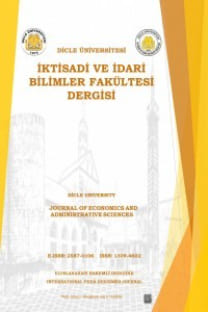URO/DOLAR PARİTESİ VE YABANCI ÜLKE GELİRİNİN İHRACAT ÜZERİNDEKİ ETKİSİ: 2003-2018 TÜRKİYE ÖRNEĞİ
Döviz kuru; hem ihraç ürünlerinin üretim maliyetlerini (özellikle yoğun ithal girdi kullanımı durumunda) hem de satış fiyatlarını önemli ölçüde etkilemektedir. Bu durum geniş bir literatür tarafından desteklendiği gibi neredeyse bütün iktisat ders kitaplarında da bahse konu olmuştur. Ancak Türkiye ihracatı üzerine yapılan birçok akademik çalışmada döviz kuru değişkeni anlamsız veya teoriye uyumsuz bulunmaktadır. Bu çalışma bu sorunu giderme noktasında farklı bir yaklaşım önermektedir. Yabancı ülke gelirleri ile çapraz döviz kuru değişkenlerinin ihracata etkisi, 2003-2018 yılları arası için çeyrek yıllık verilerle ele almıştır. Öncelikle bu değişkenlere ADF ve Phillips-Perron birim kök testleri uygulanarak değişkenlerin durağanlık seviyeleri belirlenmiştir. Daha sonra değişkenler arasındaki uzun dönem ilişki Johansen eş-bütünleşme testiyle analiz edilmiştir. Son olarak Granger nedensellik testi uygulanmıştır. Çalışmada elde edilen bulgulara göre değişkenlerin birinci dereceden entegre olduğu, serilerin eş bütünleşik olduğu ve bağımsız değişkenlerin bağımlı değişkenin Granger nedeni olduğu tespit edilmiştir.
IMPACT OF EURO/DOLLAR PARITY AND FOREIGN COUNTRY INCOME ON EXPORTS: 2003-2018 CASE OF TURKEY
Exchange rate; It significantly affects both the production costs of export products (especially in case of heavy use of imported inputs) and the selling prices. This situation is supported by a large literature and has been mentioned in almost all economics textbooks. However, many academic studies on the exchange rate variable in Turkey's exports there are insignificant. This study proposes a different approach to solving this problem. The effect of foreign country revenues and cross exchange rate variables on exports has been analyzed with quarterly data for the years 2003-2018. First of all, ADF and Phillips-Perron unit root tests were applied to these variables and the stationarity levels of the variables were determined. Then, the long-term relationship between variables was analyzed using the Johansen cointegration test. Finally, Granger causality test was applied. According to the findings obtained in the study, it was determined that the variables were first-order integrated, the series were cointegrated, and the independent variables were the Granger cause of the dependent variable.
___
- Aktaş, C., (2009), “Türkiye’nin İhracat, İthalat Ve Ekonomik Büyüme Arasındaki Nedensellik Analizi”, Kocaeli Üniversitesi Sosyal Bilimler Enstitüsü Dergisi, 18: s.35-47.
- Altıntaş H., Oz B., (2010), “Türkiye’de kur değişkenliği ve ihracat ilişkisinin ekonometrik analizi: 1989-2008”, Turgut Özal Uluslararası Ekonomi ve Siyaset Kongresi, 15-16 Nisan, Malatya, s.1963-1984.
- Barışık, S., ve Demircioğlu, E., (2006), “ TÜRKİYE’DE DÖVİZ KURU REJİMİ, KONVERTİBİLETE, İHRACAT-İTHALAT İLİŞKİSİ (1980-2001)”, ZKÜ Sosyal Bilimler Dergisi, 2(3): s.71-84.
- Berument H., Dincer N., (2005), “Denomination composition of trade and trade balance: Evidence from Turkey, Applied Economics”, Applied Economics; 37 (1): s.1177-1191.
- Coşar, E., (2002), “Price and Income Elasticities of Turkish Export Demand: A Panel Data Application” Central Bank Review, 2 (2002): s.19-53
- Demi̇rhan, E., (2015), “BÜYÜME VE İHRACAT ARASINDAKİ NEDENSELLİK İLİŞKİSİ: TÜRKİYE ÖRNEĞİ”, Ankara Üniversitesi SBF Dergisi , 60 (4): s.75-88
- Doğanlar M., Bal H. ve Özmen M., (2004), “Uluslararası Ticaret ve Türkiye’nin İhracat Fonksiyonu”, Manas Üniversitesi S.B.E Dergisi; 4 (7): s.83-109
- Erdil, T., Aydoğan, S., Ayar, B., Güvendik, Ö., Diler, S., & Gusinac, K., (2018), “İnovasyon Performansının Rekabet Gücü, Firma Performansı ve İhracat Performansı Üzerindeki Etkisi: Birleşme ve Satın Alma İşlemleri Üzerine Bir Araştırma”, Marmara Üniversitesi İktisadi ve İdari Bilimler Dergisi, 40 (2):s.137-166.
- Kahyaoğlu H. ve Utkulu U., (2006), “Euro-Dolar Paritesindeki Oynaklığın İhracat Üzerine Etkisi: Türkiye Örneği”, İktisat, İşletme ve Finans; 21 (242): s.114- 125.
- Kaplan E. ve Dayıoğlu M., (2016), “İhracatın Ekonomik Ve Politik Belirleyicileri: Türkiye İçin Var Analizi Uygulaması”, Balkan Sosyal Bilimler Dergisi, 2016 Özel Sayısı, s.578-597 .
- Kızıldere C., Kabadayı B., Emsen Ö.S., (2013), “Dış Ticaretin Döviz Kuru Değişimlerine Duyarlılığı: Türkiye Üzerine Bir İnceleme”, Uluslararası İktisadi İncelemeler Dergisi; 6 (1): s.39-53.
- Krugman, P., (1980), “Scale Economies, Product Differentiation, and the Pattern of Trade”, The American Economic Review, 70 (5): s. 950- 959.
- Kutlar, A., (2007), Ekonometriye Giriş, 1. Baskı, Nobel Yayın Dağıtım, Ankara, s.323.
- Özer, M., ve Erdoğan, L., (2006), “TÜRKİYE'DE İHRACAT, İTHALAT VE . EKONOMİK BÜYÜME ARASINDAKİ iLiŞKİLERiN ZAMAN SERİSİ ANALİZİ”, Ekonomik Yaklaşım, 17 (60-61): s.93-110.
- Resmi Gazete, (2012), “2012/8 Sayılı Yüksek Planlama Kurulu Kararı”, 28322.
- Saatçioğlu C., Karaca O., (2010), “Dolar/Euro Paritesinin Türkiye’nin İhracatına Etkisi: Ekonometrik Bir Analiz”, Niğde Üniversitesi İ.İ.B.F Dergisi; 3 (2): s.106-118.
- Senhadji, A., and Montenegro, C., (1999), “Time Series Analysis of Export Demand Equations: A Cross-Country Analysis”, IMF Stoff Papers, 46 (3): s.1-29.
- Seyidoğlu, H., (2003), Uluslararası İktisat, Teori, Politika ve Uygulama, Onbeşinci Baskı, Güzem Yayınları, İstanbul, s.17-81.
- Şiyar, C., (2020), “Türkiye’de Ekonomik Büyümeyi Etkileyen Değişkenler Üzerine Ekonometrik Bir Uygulama”, Bitlis Eren Üniversitesi Sosyal Bilimler Dergisi, 9 (1): s.123-136.
- T.C. Cumhurbaşkanlığı Strateji ve Bütçe Başkanlığı, (2019), On Birinci Kalkınma Planı 2019-2023, Ankara.
- Tunalı H ve Manga S., (2017), “The Effect Of Euro-Dollar Parıty On The Export Of Free Trade Zones Sited In Turkey: An Econometrıc Analysis”, Journal of Economic Policy Researches; 4 (2): s.35-54.
- Uyanık, S. ve Çelikel, D. C., (2019), “Türk Tekstil Endüstrisi Genel Durumu”, Teknik Bilimleri Dergisi, 9 (1): s.32-41
- World Bank Report, (2020), Trading for Development in the Age of Global Value Chains, World Bank Group.
- World Trade Organization Report, (2020), Annual Report 2020, WTO Publications.
- ISSN: 1309-4602
- Yayın Aralığı: Yılda 2 Sayı
- Başlangıç: 2011
- Yayıncı: Dicle Üniversitesi
Sayıdaki Diğer Makaleler
İTALYA'DA YEREL YÖNETİMLER VE GÜVENLİK
ÜNİVERSİTE ÖĞRENCİLERİNİN AKADEMİK MOTİVASYON ALGILARININ İNCELENMESİ ÜZERİNE BİR ALAN ÇALIŞMASI
Neslihan TANCI YILDIRIM, Yasemin KÖSE
EURO/DOLAR PARİTESİ VE YABANCI ÜLKE GELİRİNİN İHRACAT ÜZERİNDEKİ ETKİSİ: 2003-2018 TÜRKİYE ÖRNEĞİ
AVRUPA’DAKİ AŞIRI SAĞ PARTİLERİN İDEOLOJİK YAPISI
İTALYA'DA YEREL YÖNETİMLER VE GÜVENLİK
NORMATİF GÜÇ AVRUPA YAKLAŞIMI ÜZERİNDEN AB-RUSYA İLİŞKİLERİNİN DEĞERLENDİRMESİ
